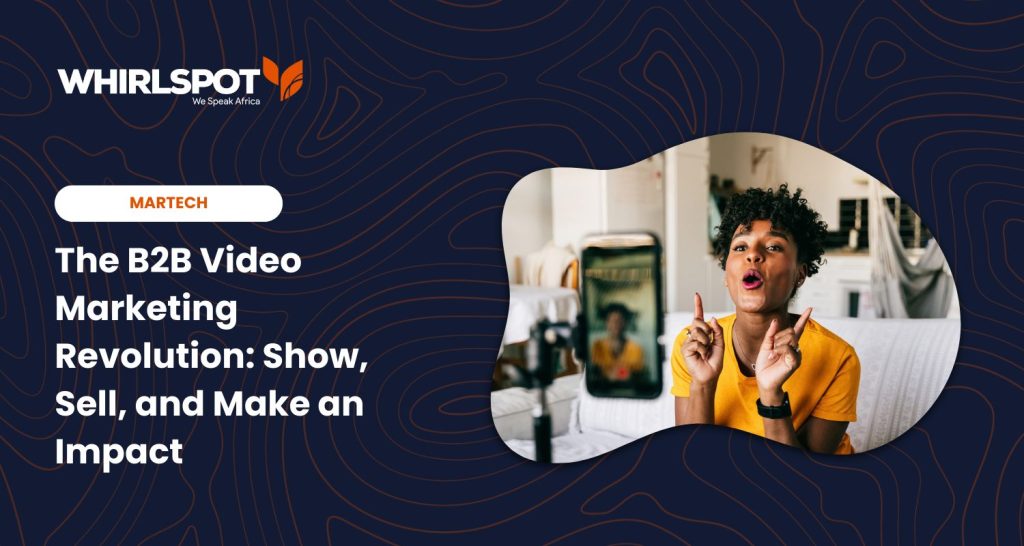Social media marketing has emerged as a powerful tool for businesses, revolutionizing how companies connect with their audiences and generate leads. Social media isn’t just for B2C brands showcasing adorable product videos and influencer partnerships. For B2B companies, this vibrant online landscape presents a goldmine of opportunities to amplify your brand voice, nurture meaningful relationships, and ultimately, fuel business growth.
But simply having a presence isn’t enough. To truly unlock its potential, you need a strategic approach that goes beyond likes and follows.
Social media allows you to humanize your brand, connect with decision-makers on a deeper level, and build trust – all crucial ingredients for success in the B2B world. Whether you’re a tech startup or a seasoned industrial manufacturer, this article is your roadmap to unlocking the unleashed potential of social media for your B2B brand.
What platforms are right? What content resonates? How do you measure success? This article delves into these questions and more, offering practical strategies and actionable insights to help B2B companies harness the power of social media and achieve their business goals.
Significance of Social Media Marketing for B2B Companies
Traditionally, B2B companies relied on more conventional marketing strategies like trade shows, email campaigns, and cold calling to reach their audience. However, the rise of social media has transformed the marketing landscape, offering a more personalized and dynamic approach to connecting with potential clients and industry peers.
- Expanding Reach and Visibility: Social media platforms have immense user bases, providing B2B companies with unprecedented opportunities to expand their reach and gain visibility among a highly targeted audience. By creating engaging content and utilizing the right social media platforms, businesses can enhance brand recognition and establish themselves as thought leaders in their respective industries.
- Relationship Building: Social media platforms enable B2B companies to build relationships with their prospects and clients on a more personal level. By engaging in conversations, responding to inquiries, and offering valuable insights, businesses can establish trust and credibility, which are vital factors in the B2B decision-making process.
- Lead Generation: Social media has become a goldmine for lead generation in the B2B context. Companies can leverage tactics like lead magnets, gated content, and interactive posts to capture valuable information from potential clients. These leads can then be nurtured through targeted content and personalized interactions, increasing the likelihood of conversion.

Understanding the Target Industry: Tailoring Social Media Marketing Strategies for Diverse B2B Sectors
While many associate social media marketing with B2C (Business-to-Consumer) industries, the significance of these platforms in the B2B (Business-to-Business) landscape cannot be underestimated. However, crafting effective social media strategies for B2B industries requires a deep understanding of the diverse nature of these sectors and how audience preferences might vary. Let’s explore the distinctive characteristics of various B2B sectors and the importance of tailored social media approaches.
-
Technology Sector
The technology industry, known for its rapid innovations and advancements, caters to businesses seeking cutting-edge solutions. Social media platforms like LinkedIn play a vital role when targeting this sector due to their professional networking features. Decision-makers and industry experts are active on LinkedIn, making it an ideal platform for thought leadership, industry updates, and establishing strong B2B connections. Twitter can also be utilized to share real-time updates, while YouTube effectively provides in-depth product demonstrations and tutorials.
-
Healthcare Sector
The healthcare industry is vast and diverse, encompassing medical devices, pharmaceuticals, and healthcare services. Social media platforms like Facebook, Instagram, and LinkedIn can be used to target different audiences within this sector. For example, pharmaceutical companies might focus on LinkedIn to engage with healthcare professionals and provide educational content, while healthcare service providers can use Facebook and Instagram to showcase their facilities and patient success stories.
-
Financial Services Sector
The financial services industry caters to a broad range of businesses, including banks, insurance companies, and investment firms. For B2B marketing in this sector, LinkedIn is once again a valuable platform to connect with financial professionals, share industry insights, and position the company as a trusted authority. Additionally, Twitter can be utilized for real-time updates on market trends and regulatory changes.
-
Manufacturing Sector
The manufacturing industry involves the production of goods and often requires business collaborations and partnerships. B2B companies can leverage platforms like LinkedIn and YouTube to engage effectively with this sector. LinkedIn can be used for business networking and sharing industry-specific content, while YouTube can showcase the manufacturing process and highlight the quality of the products.
-
Hospitality Sector
B2B companies operating in the hospitality sector need to cater to various businesses, including hotels, restaurants, and event management companies. In this case, platforms like Instagram and LinkedIn can be useful. To attract potential clients, Instagram can be utilized to share visually appealing content, such as event setups and menu items. LinkedIn, on the other hand, can be used for business collaborations and industry updates.

Choosing the Right Social Media Platforms for B2B Marketing: A Comprehensive Guide
In the dynamic world of digital marketing, harnessing the power of social media platforms is crucial for B2B companies aiming to stay ahead in the competitive landscape. However, not all social media platforms are created equal, and choosing the right ones can significantly impact a company’s success. Let’s explore various social media platforms and their relevance to B2B marketing.
1. LinkedIn:
LinkedIn stands as the undisputed leader when it comes to B2B marketing. It is a professional networking platform that offers companies the opportunity to connect with industry professionals, potential clients, and other businesses. The platform’s primary focus on business-related content makes it an ideal choice for B2B marketers.
Strengths:
- Extensive network of professionals: With over 774 million users, LinkedIn provides access to a vast pool of decision-makers and industry leaders.
- Targeted advertising options: Robust advertising tools allow businesses to target specific demographics, job titles, industries, and company sizes.
- Thought leadership opportunities: Through long-form posts and articles, businesses can establish themselves as industry thought leaders.
Weaknesses:
- Limited engagement for certain industries: Industries that don’t naturally lend themselves to visually engaging content may find it challenging to capture audience attention.
- Higher competition for visibility: As the go-to platform for B2B, competition for audience attention can be fierce.
2. Twitter:
Twitter is a fast-paced microblogging platform that fosters real-time communication. While it may not be the primary platform for B2B marketing, it can still offer valuable opportunities.
Strengths:
- Instant customer service: B2B companies can provide quick customer support and engage directly with their audience.
- Real-time updates and trends: Twitter allows businesses to stay up-to-date with industry trends and join relevant conversations.
Weaknesses:
- Character limit: The character limit can be restricting when trying to convey complex B2B messages.
- Low engagement for some B2B industries: Industries with more technical or specialized products/services may find it challenging to generate meaningful engagement.
3. Facebook:
Facebook is the largest social media platform globally, with a diverse user base. Although it has a more significant B2C presence, Facebook can still be relevant for B2B companies in certain cases.
Strengths:
- Wide audience reach: With over 2.8 billion monthly active users, Facebook offers access to a massive audience.
- Advanced ad targeting: The platform’s ad targeting capabilities allow businesses to reach specific demographics and interests.
Weaknesses:
- Declining organic reach: Algorithm changes have significantly reduced the organic reach for business pages, requiring increased investment in paid advertising.
- Lower engagement for B2B: Facebook’s casual nature may not be the best fit for certain B2B industries.
4. YouTube:
YouTube is the world’s second-largest search engine, making it an invaluable platform for B2B companies looking to deliver engaging and informative video content.
Strengths:
- Video content potential: Complex B2B solutions can be explained effectively through videos, enhancing audience understanding.
- SEO benefits: YouTube videos often rank well in Google search results, expanding a company’s online visibility.
Weaknesses:
- Resource-intensive: Creating high-quality video content requires significant time, effort, and resources.
- Longer attention span required: B2B audiences may not have the patience for longer videos compared to B2C audiences.

The Power of Valuable Content Creation for B2B Audiences
With businesses increasingly embracing social media to connect with their target audience, the significance of delivering valuable and relevant content cannot be overstated. In the B2B realm, decision-makers and professionals are inundated with vast amounts of information every day. To stand out amidst the noise, businesses must offer valuable content that addresses their audience’s pain points, solves problems, and provides actionable insights. Valuable content establishes a business as a thought leader, fosters trust, and nurtures long-term relationships with potential customers.
-
Informative Posts
Creating informative posts that educate and engage your B2B audience is fundamental to content creation. Industry insights, market trends, and tips relevant to your target audience’s interests should take center stage. Leverage data-backed research, statistics, and real-life examples to provide credibility to your content. Always ensure that your posts are concise, easy to read, and tailored to your audience’s preferences.
-
Captivating Infographics
Infographics are a visually appealing and effective way to convey complex information in a digestible format. B2B decision-makers often have limited time, and infographics allow them to grasp essential data quickly. Use vibrant visuals, charts, and graphs to present data-driven insights. Infographics can cover various topics, from explaining processes and comparisons to showcasing industry trends.
-
Compelling Case Studies
Case studies are a powerful content format that showcases real-life success stories. They demonstrate how your products or services have helped other businesses overcome challenges and achieve their goals. B2B buyers are drawn to evidence-backed results and want to see how your solutions can impact their bottom line. Include quantifiable metrics and testimonials to reinforce credibility and build trust.
-
Interactive Content
Interactive content, such as quizzes, polls, and surveys, enhances engagement and fosters a sense of participation among the audience. B2B buyers are more likely to remember and share content that actively involves them. Interactive formats also provide valuable data and insights into your audience’s preferences and pain points, helping you refine your marketing strategy further.
-
Thought Leadership Pieces
Establishing thought leadership is crucial in the B2B space. Publish in-depth articles and whitepapers that dive into industry trends, emerging technologies, and best practices. Thought leadership pieces position your brand as an authoritative source of information and can drive traffic from both your existing and potential customers.

Leveraging LinkedIn for B2B Success: Unleashing the Power of Professional Networking
In the rapidly evolving world of B2B marketing, social media platforms have emerged as invaluable tools for businesses to connect with potential clients and partners. Among these, LinkedIn is the premier platform for professional networking and lead generation. With over 774 million members worldwide, LinkedIn’s dominant role in the B2B space cannot be underestimated. Let’s explore the strategies to maximize LinkedIn’s potential for effective networking, lead generation, thought leadership, and ultimately B2B success.
1. Building an Impressive LinkedIn Profile
The first step towards leveraging LinkedIn for B2B success is to establish a compelling and professional profile. A complete and well-optimized profile enhances your credibility and attracts potential leads. Ensure your profile includes a clear and engaging headline, a professional photo, and a summary that showcases your expertise and value proposition. Highlight past achievements, skills, and endorsements to strengthen your credibility. Regularly update your profile to reflect your latest achievements and contributions.
2. Effective Networking: Quality over Quantity
LinkedIn’s strength lies in its emphasis on professional connections. Rather than aiming for a vast number of connections, prioritize building meaningful relationships with relevant individuals and businesses in your industry. Target decision-makers, potential clients, and industry influencers. Personalize your connection requests to express genuine interest in their work and highlight mutual benefits. Engage with their content, participate in relevant discussions, and always respond promptly to messages or comments. Thoughtful networking can lead to valuable partnerships and open doors to new opportunities.
3. Lead Generation Strategies
LinkedIn is a goldmine for B2B lead generation when approached strategically. Here are some effective strategies:
- Utilize Advanced Search: LinkedIn’s Advanced Search feature enables you to narrow down prospects based on various criteria, such as industry, job title, company size, and location. Leverage these filters to identify potential clients or partners.
- Engaging Content Marketing: Create and share valuable content that addresses the pain points of your target audience. Demonstrating your expertise through articles, posts, and videos can attract potential leads and position your brand as a thought leader.
- Sponsored Content and InMail Campaigns: Utilize LinkedIn’s advertising tools to promote your content and reach a wider audience. InMail campaigns can be especially effective in delivering personalized messages to prospects.
- Participate in Groups: Join and actively engage in LinkedIn groups relevant to your industry. Share insights, answer questions, and build your reputation as a knowledgeable professional, which can lead to potential leads seeking out your expertise.
4. Thought Leadership and Brand Authority
Establishing thought leadership on LinkedIn is crucial for gaining trust and credibility within your industry. Consider the following approaches:
- Publish Long-form Content: Write insightful articles that address industry trends, challenges, and solutions. Providing value through your content can position you as an industry authority and attract followers.
- Engage in Thoughtful Discussions: Participate in group discussions, comment on posts, and share your perspectives on relevant topics. Engaging in thoughtful conversations can enhance your reputation and visibility.
- Showcase Success Stories: Share case studies and success stories that highlight how your products or services have benefited clients. Real-life examples can build confidence in potential buyers.

Utilizing Twitter for B2B Engagement
Social media has become a powerful tool for businesses to engage with their target audience and build meaningful relationships. Among the various platforms available, Twitter is a versatile platform for B2B companies to connect with prospects, customers, and industry influencers. Let’s explore the effective use of Twitter for B2B engagement, tweet strategies, Twitter Spaces, and hashtags for better visibility.
1. Crafting Compelling Tweets:
The key to successful B2B engagement on Twitter lies in crafting compelling tweets that resonate with the audience. Here are some tweet strategies to consider:
- Share Valuable Content: B2B audiences crave relevant and valuable content. Share industry insights, thought leadership pieces, case studies, and whitepapers that showcase your expertise and establish your brand as a trusted authority.
- Visual Appeal: Add eye-catching visuals like images, infographics, and videos to your tweets to increase engagement. Visual content is more likely to catch the audience’s attention and encourage them to interact with your tweets.
- Calls-to-Action (CTAs): Encourage interaction by including clear CTAs in your tweets. Ask questions, seek opinions, or prompt users to retweet and like your content, fostering engagement and amplifying your reach.
- Personalization: Tailor your tweets to specific segments of your target audience. Personalized content resonates better with users and makes them feel valued.
2. Leveraging Twitter Spaces:
Twitter Spaces are real-time discussions centred around a specific hashtag, offering B2B companies a powerful way to engage with their audience and industry peers. Here’s how to make the most of Twitter Spaces:
- Choose Relevant Topics: Select timely, relevant topics that resonate with your target audience. Partner with industry influencers or thought leaders to co-host the Spaces, adding credibility and expanding the reach.
- Promote the Spaces: Create anticipation for the Spaces by promoting it across your social media channels and website. Encourage participants to invite their followers, increasing the chat’s visibility.
- Engage Actively: During the Spaces, actively respond to participants, answer questions, and retweet valuable contributions. Acknowledge and appreciate the involvement of attendees, fostering a positive and interactive environment.
- Analyze and Improve: After the Spaces, analyze its performance using Twitter analytics. Identify what worked well and what needs improvement, enabling you to refine your approach for future Spaces.
3. Harnessing the Power of Hashtags:
Hashtags are instrumental in increasing your tweets’ visibility and engagement on Twitter. Here’s how B2B companies can effectively use hashtags:
- Research Industry-Relevant Hashtags: Identify trending and popular hashtags within your industry. Use tools like Hashtagify or Twitter’s search function to discover the most relevant ones.
- Create Branded Hashtags: Develop unique branded hashtags for your B2B campaigns, events, or product launches. Branded hashtags can facilitate conversations around your brand and help you monitor campaign performance.
- Avoid Overstuffing: Use a limited number of hashtags per tweet (1-3) to maintain readability and avoid appearing spammy. Overuse of hashtags may distract users from your message.

Leveraging Visual Content: Instagram and Pinterest for B2B Companies
Instagram and Pinterest have firmly established themselves as powerhouse social media platforms for engaging consumer audiences. With their visually-driven nature, these platforms have been widely adopted by businesses targeting B2C markets. However, B2B companies can also harness the power of visual content on Instagram and Pinterest to effectively convey their messages, showcase products or services, and ultimately drive valuable business outcomes.
While Instagram and Pinterest may primarily cater to consumer-oriented businesses, B2B companies should not overlook the potential these platforms offer. Both Instagram and Pinterest have seen a surge in business-related activities as professionals seek inspiration, networking opportunities, and industry trends.
1. Building Brand Awareness and Trust
Establishing a strong brand presence is crucial for any company regardless of the target audience. Instagram and Pinterest provide B2B companies with a platform to showcase their brand personality, culture, and expertise through visually appealing content. Sharing behind-the-scenes glimpses, employee stories, and thought leadership posts can help humanize the brand, fostering trust and connection with potential clients.
2. Telling Compelling Stories
Visual content can be a powerful storytelling tool. B2B companies can leverage Instagram and Pinterest to creatively narrate their success stories, client testimonials, and case studies. Using a mix of high-quality images, infographics, and short videos, they can illustrate their products or services’ positive impact on clients, thus compelling new prospects to engage.
3. Demonstrating Product or Service Value
Incorporating visuals into product demonstrations can significantly enhance B2B companies’ ability to convey complex information in a digestible format. Instagram Stories and Pinterest Pins can be used to showcase product features, practical applications, and unique selling points, leading to a better understanding of the offering by potential customers.
Creative Ways to Utilize Visual Content for B2B Messages
-
Infographics and Data Visualization
Infographics are ideal for presenting data-driven insights and industry trends. B2B companies can create visually captivating infographics highlighting key statistics, market research findings, or performance metrics relevant to their sector. The visual appeal of infographics makes complex information more engaging and shareable.
-
Video Content
Videos are a highly engaging format that can breathe life into otherwise static B2B messages. Companies can create product explainer videos, customer success stories, or behind-the-scenes clips to foster a deeper connection with their audience. Instagram Reels and Pinterest Video Pins offer excellent opportunities for showcasing dynamic content.
-
User-Generated Content (UGC)
Encouraging customers to share their experiences with products or services through UGC can be a powerful way to boost brand credibility. B2B companies can repost UGC on their profiles, highlighting the real-world applications of their offerings and building a sense of community around their brand.
-
Influencer Collaborations
Identifying influencers or industry thought leaders who align with the company’s values can amplify B2B messages. Collaborating with influencers for sponsored posts or takeovers can extend the brand’s reach to a relevant and engaged audience.

Leveraging Visual Content: Instagram and Pinterest for B2B Companies
Instagram and Pinterest have firmly established themselves as powerhouse social media platforms for engaging consumer audiences. With their visually driven nature, these platforms have been widely adopted by businesses targeting B2C markets. However, B2B companies can also harness the power of visual content on Instagram and Pinterest to effectively convey their messages, showcase products or services, and ultimately drive valuable business outcomes.
While Instagram and Pinterest may primarily cater to consumer-oriented businesses, B2B companies should not overlook the potential these platforms offer. Both Instagram and Pinterest have seen a surge in business-related activities, as professionals seek inspiration, networking opportunities, and industry trends.
-
Building Brand Awareness and Trust
Establishing a strong brand presence is crucial for any company regardless of the target audience. Instagram and Pinterest provide B2B companies with a platform to showcase their brand personality, culture, and expertise through visually appealing content. Sharing behind-the-scenes glimpses, employee stories, and thought leadership posts can help humanize the brand, fostering trust and connection with potential clients.
-
Telling Compelling Stories
Visual content can be a powerful storytelling tool. B2B companies can leverage Instagram and Pinterest to creatively narrate their success stories, client testimonials, and case studies. Using a mix of high-quality images, infographics, and short videos, they can illustrate their products or services’ positive impact on clients, thus compelling new prospects to engage.
-
Demonstrating Product or Service Value
Incorporating visuals into product demonstrations can significantly enhance B2B companies’ ability to convey complex information in a digestible format. Instagram Stories and Pinterest Pins can be used to showcase product features, practical applications, and unique selling points, leading to a better understanding of the offering by potential customers.
Creative Ways to Utilize Visual Content for B2B Messages
-
Infographics and Data Visualization
Infographics are ideal for presenting data-driven insights and industry trends. B2B companies can create visually captivating infographics that highlight key statistics, market research findings, or performance metrics relevant to their sector. The visual appeal of infographics makes complex information more engaging and shareable.
-
Video Content
Videos are a highly engaging format that can breathe life into otherwise static B2B messages. Companies can create product explainer videos, customer success stories, or behind-the-scenes clips to foster a deeper connection with their audience. Instagram Reels and Pinterest Video Pins offer excellent opportunities for showcasing dynamic content.
-
User-Generated Content (UGC)
Encouraging customers to share their experiences with products or services through UGC can be a powerful way to boost brand credibility. B2B companies can repost UGC on their profiles, highlighting the real-world applications of their offerings and building a sense of community around their brand.
-
Influencer Collaborations
Identifying influencers or industry thought leaders who align with the company’s values can amplify B2B messages. Collaborating with influencers for sponsored posts or takeovers can extend the brand’s reach to a relevant and engaged audience.

Embracing the Power of Video Marketing in B2B: A Pathway to Success
Video content has emerged as a formidable force, revolutionizing the way businesses connect with their target audience. While once considered solely for B2C marketing, videos are also carving a significant space in the B2B landscape. The growing popularity of video marketing has compelled B2B companies to adapt and harness its potential to enhance engagement, build brand awareness, and drive conversions. In recent years, video has become a central element of digital marketing strategies for B2B companies. The reason for this shift is the changing preferences of modern audiences.
Decision-makers and professionals are increasingly drawn to visual and interactive content, making videos an ideal medium to captivate and educate them. Furthermore, the video’s ability to humanize a brand and engagingly convey complex information adds to its appeal. As B2B sales cycles can be lengthy and involve multiple stakeholders, video content bridges the gap, expediting decision-making and fostering stronger relationships.
Leveraging Video Content in B2B Marketing
- Product Demos and Explainer Videos: Demonstrating products or services in action helps B2B buyers understand their benefits and how they address their pain points. Explainer videos simplify complex concepts and give prospects a clearer view of what a solution entails.
- Customer Testimonials and Case Studies: Real-life success stories from satisfied customers instil trust in potential buyers. Sharing testimonials and case studies as video content showcases the effectiveness of a product or service.
- Thought Leadership Content: Establishing thought leadership is crucial in the B2B space. Industry insights, expert interviews, and webinars in video format position a company as an authority, attracting prospects seeking valuable information.
- Behind-the-scenes: Providing a glimpse into the company’s culture, operations, and team fosters a deeper connection with prospects. Such videos can portray authenticity and transparency, vital factors for building trust.
- Event Coverage and Recap: For B2B companies participating in or hosting industry events, capturing and sharing the experience through video enhances engagement and extends the event’s reach.
Choosing the Right Platforms for B2B Video Hosting
Selecting the appropriate platforms to host video content is as essential as creating compelling videos themselves. The following platforms are well-suited for B2B companies looking to maximize the impact of their video marketing efforts:
- YouTube: As the world’s second-largest search engine, YouTube offers unrivalled reach and discoverability. B2B companies can create a dedicated channel to showcase their expertise, upload thought leadership content, and optimize videos for relevant keywords.
- LinkedIn: As the leading professional networking platform, LinkedIn is an excellent medium for B2B video marketing. Native video posts and LinkedIn Live enable companies to connect directly with their target audience and gain industry visibility.
- Company Website: Embedding videos on the company website allows B2B buyers to access valuable content while browsing. This ensures a seamless user experience and keeps prospects engaged with the brand.
- Email Campaigns: Incorporating video content in email campaigns can significantly increase open rates and click-through rates. It’s an effective way to deliver personalized messages and encourage action from prospects.
- Webinars and Virtual Events: Hosting webinars or virtual events is an excellent opportunity to engage prospects through live video interactions, fostering relationships and generating leads.

Building a Thriving Community on Facebook: Strategies for B2B Companies
Social media platforms have become an indispensable part of business-to-business (B2B) marketing strategies, and Facebook continues to lead the way in connecting businesses with their target audience. Building and nurturing a vibrant community on Facebook can yield numerous benefits for B2B companies, fostering engagement, and brand loyalty among customers.
1. Establishing a Facebook Group
One of the first steps in building a community on Facebook is creating a dedicated group for your B2B company. Facebook Groups offer a space where like-minded individuals can come together to discuss topics related to your industry, share insights, and ask questions. Here are some key pointers for successful group management:
- Define a Clear Purpose: Clearly outline the purpose and objectives of your group in the description. Ensure that it aligns with your company’s values and caters to the needs of your target audience.
- Create Engaging Content: Regularly share valuable content such as articles, industry updates, case studies, and videos. Encourage group members to contribute, fostering a sense of ownership within the community.
- Facilitate Meaningful Discussions: Actively moderate the group to ensure respectful and relevant discussions. Encourage members to ask questions and participate in conversations to create a dynamic and engaging atmosphere.
- Recognize and Reward Active Members: Acknowledge and appreciate the contributions of your most engaged members. This could be through features like “Member of the Month” or exclusive benefits for active participants.
2. Promoting Events to Foster Community Participation
Hosting events within your Facebook community can be an effective way to enhance engagement and brand loyalty. Events can take various forms, such as webinars, live Q&A sessions, workshops, or virtual conferences. Here’s how to leverage events to their full potential:
- Create Compelling Event Pages: Craft visually appealing and informative event pages that clearly communicate the event’s purpose, date, time, and any special guests or speakers. Use eye-catching visuals and compelling copy to attract attendees.
- Leverage Live Video: Utilize Facebook Live to host real-time events. Live video has the advantage of instant interaction with participants, allowing for questions, polls, and real-time feedback.
- Collaborate with Industry Influencers: Partner with influential figures in your industry to co-host or speak at your events. This not only boosts event credibility but also attracts a wider audience.
- Follow Up with Post-Event Engagement: After the event, encourage participants to share their experiences, feedback, and takeaways. Continue the discussion and share related content to keep the momentum going.
3. Providing Stellar Customer Support
A vital aspect of community-building on Facebook is offering top-notch customer support. Prompt and helpful responses to customer inquiries can significantly enhance brand perception and customer satisfaction. Here are some strategies for effective customer support:
- Designate a Support Team: Assign dedicated staff members to monitor the Facebook group and promptly respond to questions and concerns. Ensure that the team is well-versed in your products and services.
- Offer Timely Responses: Aim to respond to customer inquiries as quickly as possible, even if it’s to acknowledge their message and inform them that their concern is being addressed.
- Personalize the Experience: Address customers by their names and personalize responses whenever applicable. This adds a human touch and demonstrates that your company values its customers.
- Proactively Seek Feedback: Encourage customers to share their thoughts and suggestions openly. Act on constructive feedback to show that you value their opinions and are committed to improvement.
Measuring Success: KPIs and Analytics in B2B Social Media Marketing
For B2B (Business-to-Business) companies, social media marketing offers a valuable platform to connect with potential clients, build brand credibility, and foster lasting relationships with industry peers. However, simply having a social media presence is not enough; tracking and analyzing performance through Key Performance Indicators (KPIs) is crucial for success. For B2B companies, social media can play a vital role in driving growth, lead generation, and revenue. Here are some reasons why tracking social media marketing performance is essential:
- Understanding ROI: Measuring the return on investment (ROI) is critical for any marketing effort. Tracking social media metrics allows B2B companies to evaluate the effectiveness of their campaigns, helping them allocate resources wisely.
- Enhancing Targeting and Engagement: Analytics provide insights into audience behavior and preferences, enabling B2B companies to refine their content and engagement strategies for better results.
- Competitive Advantage: Monitoring performance allows businesses to benchmark themselves against competitors and identify areas of improvement.
- Optimizing Campaigns: Real-time data empowers B2B companies to make informed decisions and adapt their social media campaigns on the fly, improving overall performance.
Key Performance Indicators (KPIs) for B2B Social Media Campaigns
- Engagement Rate: This KPI measures the level of interaction with social media content, such as likes, shares, comments, and clicks. A high engagement rate indicates that the content resonates well with the audience.
- Click-Through Rate (CTR): CTR measures the percentage of users who clicked on a specific link or Call-to-Action (CTA) in a social media post, leading them to the company’s website or landing page. A high CTR indicates that the content is compelling and relevant to the target audience.
- Lead Generation and Conversion Rate: Tracking the number of leads generated through social media and their conversion into customers is crucial for B2B companies. This KPI directly ties social media efforts to revenue generation.
- Brand Mentions and Sentiment: Monitoring brand mentions and sentiment (positive, negative, or neutral) helps assess brand reputation and identify potential issues that need addressing.
- Follower Growth: While vanity metrics should not be the sole focus, tracking the growth in social media followers provides insights into the effectiveness of content and overall brand appeal.
- Reach and Impressions: Reach measures the total number of unique users who see a social media post, while impressions track the total number of times the post is displayed. Both metrics indicate the potential audience reached and the content’s visibility.
Tools for Monitoring Analytics
To track and analyze B2B social media marketing performance effectively, businesses can leverage various analytics tools:
- Facebook Insights: For businesses active on Facebook, Facebook Insights offers a comprehensive dashboard with key metrics related to page performance, audience engagement, and post reach.
- Twitter Analytics: Twitter provides an analytics dashboard that offers valuable data on tweet performance, audience demographics, and follower growth.
- LinkedIn Page Analytics: B2B companies can access LinkedIn’s analytics to gain insights into their company page’s performance, follower demographics, and engagement metrics.
- Google Analytics: By integrating Google Analytics with social media platforms, businesses can track website traffic generated through social media and tie it to specific campaigns.
- Social Media Management Platforms: Tools like Hootsuite, Buffer, and Sprout Social allow businesses to manage multiple social media accounts in one place and offer analytics to track performance across platforms.
Personalization and Account-Based Marketing (ABM) on Social Media
In the rapidly evolving landscape of B2B marketing, personalization has emerged as a crucial aspect of social media strategies. As businesses seek to establish meaningful connections with their audience, tailoring content and engagement to individual preferences becomes essential. In tandem with personalization, Account-Based Marketing (ABM) has gained traction as an effective strategy to target high-value accounts and secure valuable partnerships.
Personalization in B2B social media marketing revolves around understanding individual prospects or accounts’ unique needs and pain points. By leveraging data and analytics, marketers can craft highly relevant and tailored content that resonates with their target audience. The benefits of personalization in B2B social media marketing include:
- Enhanced Engagement: Personalized content grabs the attention of prospects, increasing the likelihood of engagement, such as likes, shares, and comments.
- Building Trust: When businesses address the specific challenges faced by their audience, it establishes trust and credibility, paving the way for a stronger business relationship.
- Improved Conversion Rates: Personalization increases the chances of converting leads into customers as prospects feel understood and valued.
- Strengthening Customer Loyalty: By consistently delivering personalized experiences, businesses can foster long-lasting customer loyalty and advocacy.
Executing Account-Based Marketing (ABM) on Social Platforms
ABM is a targeted marketing approach that focuses on engaging a select group of high-value accounts. By understanding these accounts’ unique needs and preferences, marketers can deliver personalized content and experiences that resonate on a deeper level. Here are some steps to execute ABM on social media platforms:
- Identify and Prioritize Target Accounts: Work closely with the sales team to identify key accounts based on their potential value and relevance to your business. Prioritize these accounts based on their fit with your offerings and their likelihood to convert.
- Gather Account Insights: Conduct thorough research on each target account to understand their industry, pain points, goals, and recent activities. Utilize social media monitoring tools to keep track of their engagements and interactions.
- Create Account-Specific Content: Craft content that addresses each target account’s specific challenges and interests. Tailor messaging and visuals to align with their industry and business objectives.
- Personalized Outreach: Engage with key decision-makers and stakeholders from the target accounts through personalized messages and comments on their social media posts. This interaction should be genuine and focused on providing value.
- Leverage Social Advertising: Utilize the advanced targeting options social media platforms offer to reach individuals within the target accounts. Tailor the ad messaging to resonate with their specific pain points and aspirations.
- Measure and Optimize: Track the performance of your ABM efforts on social media. Monitor engagement rates, click-throughs, and conversions. Use the insights gained to optimize your strategies continuously.
Tips for Tailoring Content and Engagement
- Segment Your Audience: Divide your target audience into smaller segments based on industry, role, or interests. This segmentation allows for more personalized content creation.
- Use Social Listening: Monitor conversations and interactions on social media to gain insights into what your target accounts care about and how they engage with content.
- Leverage User-Generated Content (UGC): Incorporate UGC from your target accounts into your content strategy. This fosters a sense of community and demonstrates your commitment to your customers.
- Implement Dynamic Content: Use dynamic content personalization tools to tailor your social media posts in real time based on user behavior and preferences.
- Utilize Social Media Analytics: Analyze the performance of your social media campaigns regularly. Metrics like engagement rates, click-throughs, and conversions help measure the effectiveness of your personalized content.
Social media marketing presents immense opportunities for B2B companies to showcase their expertise, connect with their target audience, and drive business growth. By setting clear objectives, selecting the right platforms, producing engaging content, leveraging influencers, and engaging with the audience, B2B companies can effectively navigate the social media landscape. By consistently measuring and refining strategies, B2B companies can build a strong online presence, foster brand loyalty, and drive tangible results in the competitive digital landscape.







